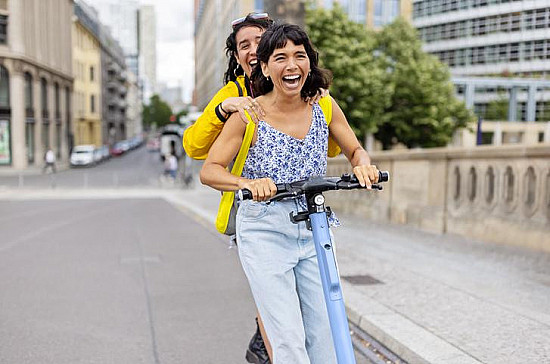
Ever ridden an e-scooter or e-bike? The convenience, affordability, and flat-out fun of these “micromobility” modes of transportation are undeniable. But did it also seem a bit dangerous?
In fact, the rate of accidents involving e-bikes and e-scooters is climbing. Maybe that shouldn’t be surprising given their dramatic jump in popularity. And then there’s the way riders often use them: at high speed, near cars and pedestrians, and on roads and sidewalks that weren’t designed for them.
Disruptive innovations, such as e-bikes and e-scooters, inevitably come with downsides. So, how can we minimize risks for accidents?
E-bikes, e-scooters, and injuries
Between 2018 and 2022, sales of e-bikes rose from around 250,000 per year to more than a million. E-bike and e-scooter rentals have also increased dramatically. As their popularity grows, emergency rooms are seeing many more people injured while riding e-bikes and e-scooters.
A 2024 study in JAMA Network Open highlights this. Researchers drew data from the National Electronic Injury Surveillance System, which is run by the US Consumer Product Safety Commission. They analyzed ER care between 2017 and 2022 for people injured while riding an e-bike or e-scooter, compared with people injured while riding conventional bikes and scooters.
What did the study find?
During the six-year study period, roughly three million people riding e-bikes, e-scooters, or their conventional counterparts sought care in the ER, including about 45,500 e-bike riders and 190,000 e-scooter riders, and about 2.5 million conventional bike riders and 305,000 conventional scooter riders.
Certain themes emerged around e-micromobility:
ER care spiked upward
- E-bike injuries more than doubled every year, going from 751 in 2017 to 23,493 in 2022.
- E-scooter injuries increased by more than 45% every year, going from 8,566 in 2017 to 56,847 in 2022.
More risky behavior
- 43% of e-bike and e-scooter riders wore helmets versus 52% for conventional micromobility riders
- 7% of e-bike riders and 9% of e-scooter riders were drinking before their accidents versus 4% of conventional bike riders and 3% of conventional scooter riders.
More accidents occurred in urban areas compared with rural settings:
- 83% of e-bike and e-scooter accidents
- 71% of conventional bike and scooter accidents.
All riders experienced similar types of injuries: scrapes, bruises, broken bones, and head and neck injuries were most common.
What are the limitations of this study?
This study only included people evaluated in an ER, so it excluded people with less severe injuries — and even those with significant injuries who didn’t go to an ER. Some may have sought no care at all, or gone to a primary care practice or walk-in clinic to avoid costly ER care or for other reasons.
Nor did the study count injuries suffered by pedestrians injured by e-bike or e-scooter riders. Property damage, such as damage to a car, wasn’t calculated.
And ultimately the study cannot compare the safety of e-bikes and e-scooters with conventional options. That’s because no data were collected on the number of miles traveled using a particular mode of transportation, or over how much time.
How can you avoid e-bike or e-scooter injuries?
Ten common-sense precautions can help you avoid injuries and ER visits:
- Wear a helmet. If you’re renting an e-bike or e-scooter, you may need to bring your own since many rental systems do not provide helmets.
- Practice. E-bikes are much heavier than conventional bicycles and may handle differently. And many adults have not ridden a scooter since elementary school! So if you aren’t familiar with riding an e-bike or e-scooter, practice in a safe location where there’s no traffic or pedestrians.
- Follow road rules. Ride on available bike lanes and avoid sidewalks. Use arm signals to alert those nearby of your intentions to turn or change lanes.
- Slow down. Some e-bikes approach speeds of 30 miles per hour. The faster you go, the less time you have to react to unexpected potholes or veering vehicles, and the more serious an injury is likely to be if you have an accident.
- Lower risks. Don’t ride while under the influence of alcohol or drugs, or use your phone while moving.
- Go it alone. Don’t add riders. Most e-bikes and e-scooters are built for one rider at a time.
- Ride defensively. Watch out for potholes or opening car doors.
- Reflect. Wear reflective clothing or attach a light if riding at night.
- Call out. Announce your presence to others. For example, shout “on your left!” as you approach pedestrians or slower riders that you intend to pass.
- Lobby. Reach out to local politicians to create bike lanes and other infrastructure to make micromobility safer.
The bottom line
Whether it’s part of your daily commute, an occasional quick zip from point A to point B, or just a ride for the fun of it, e-bikes and e-scooters are a great way to get around. Though they do come with some risk, you can do a lot to minimize the odds of wrapping up your travels with a trip to an ER.
